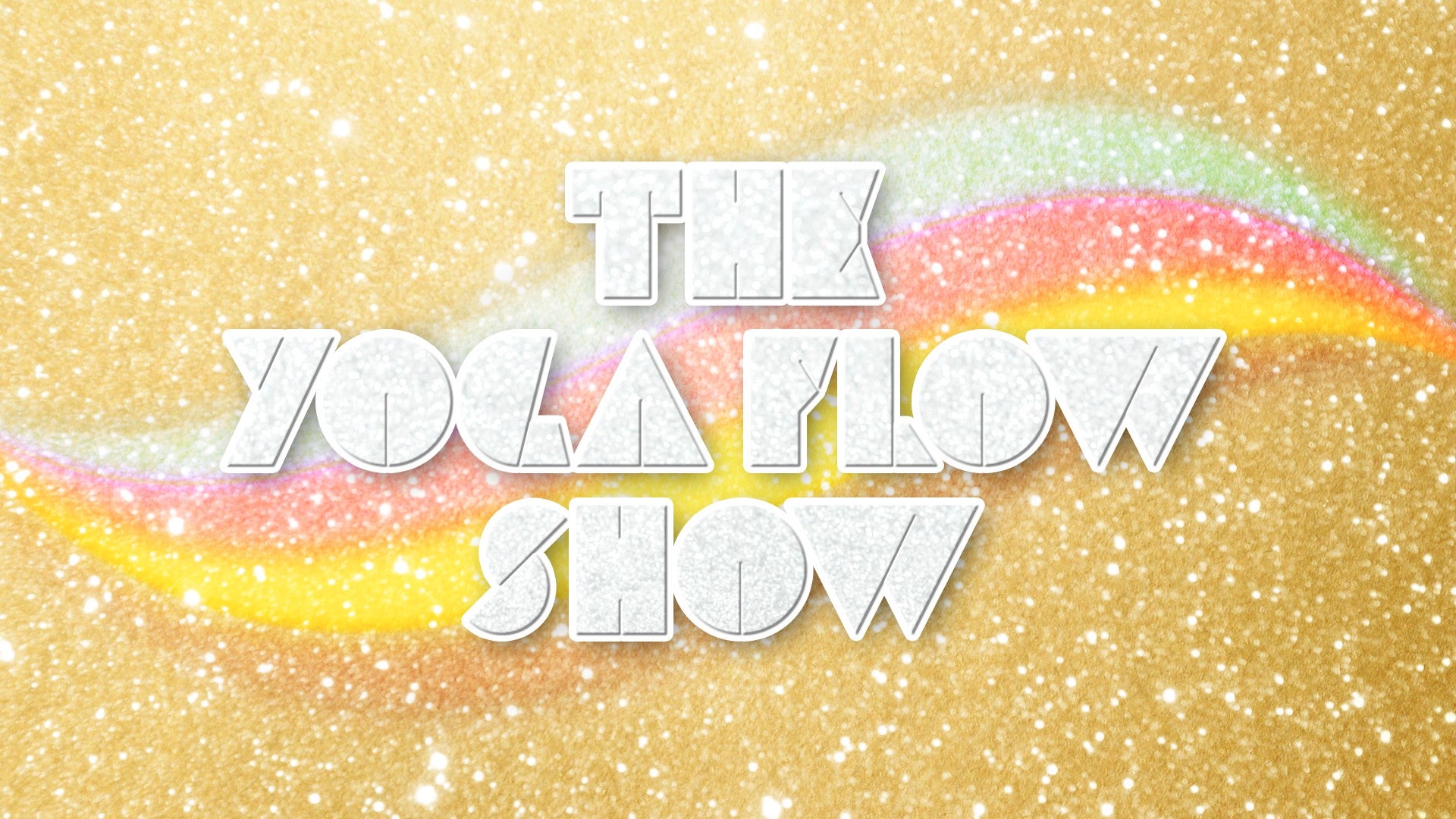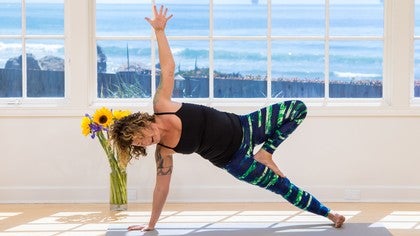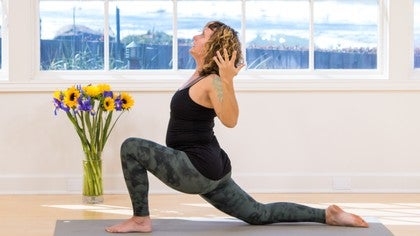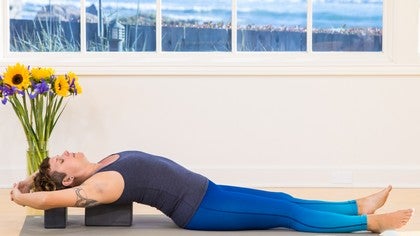Description
About This Video
Transcript
Read Full Transcript
(waves crashing) Hi, welcome to your practice. So, this is a little DIY massage. I have a very active toddler, and an active life, and as much as I would love to get massages all the time, sometimes it's not as available to me as I'd like, and so this is a way that I've started to incorporate that kind of self-care into my own home practice. That's accessible at any point. And so the way that you can use this video is you can just come in and take one part, right, and just practice that, or you can do it all together, or certain sections.
And I'll walk you through each piece, but you can feel free to stay and linger as long as you need to. So first ones will kind of work on our back. You're gonna need two blocks. That is part of the practice. So we will start on our backs.
(clears throat) And for here you just use the one block. Come on down. And when you take the block, it can be either on low or medium setting. I have a teacher at my studio who says the baby bear and the mama bear setting. So baby bear and mama bear (chuckles).
And we come behind and take it behind the neck. So there's a way to place it where it's more on the skull. And this is actually on the neck, so that the ridge hits all of that ropey goodness, like the spot where you want your sweetie to be like, ooh, dig in. You can also do medium setting, and for some people they like to tilt it a little bit. So take your time here, and like, find the goods.
This is what it's all about. So you wanna like, feel in, and be like, oh yeah. That is a nugget of information. And that's the spot you wanna be in. We start neutral, the hands can relax.
They can be on the belly, or anywhere that feels comfortable is totally fine. Knees can be bent, they can also extend out. Again, anywhere that's comfortable. And we slowly start to turn the gaze over to this side. And we're using gravity, and the edge of the block, to just get in to all of that good, sweetness in the neck.
Any sort of tension, and releasing it out. And so, what might be needed, is really slow turns of the gaze right to left. They're slowly moving they head from side to side, in just continual motion. Or it might be like nothing, nothing, nothing, oh my goodness. And you hit a spot that has some information for you, has something to share, and you stay there.
And you just let the pressure of the block and gravity and the meeting there in that spot, to meet and release it out. Like a little bit of pressure-point massage work. And you stay and you breathe for as long as you need, until some of that tension or maybe a lot of that tension releases. And then you move on, and again, it could be continual motion, or it might be like oh, not much, not much, (gasps) there it is, and you find another nugget of information. And you allow your body to soften and receive here.
Back and forth. And eventually you'll feel nice and even, and you'll come through center and you'll take a few breaths here. So again, this is this invitation to pause, video at any point, and stay here. Stay and work this shape as long as you need, with as much time and space as needed. Otherwise when you're done, you feel good, center, resting, just taking a breath or two here.
And then we'll release the block out from underneath the head and put it to the side for just a moment, and we'll turn the gaze to the right, really simple. Lift up and turn the gaze to the left. Come back through center. And then we re-find our block. So here we're definitely on baby-bear setting, so on the lowest setting.
Plant the feet, lift the hips. Take the block underneath. So the joke is, if the block feels like it's in your lower back, it is in your lower back, and you want it low. So the tailbone is the tip of our sacrum, and it's this triangle part of the back of our pelvis. And you want the block to be on that solid bone piece.
So it's not in the waistline. It's not shoved into the lower back, which won't feel comfortable. You almost maybe are lower than you think, right, so it's pretty low. It's towards the tailbone more than up at the waistline. And then we take, so you start to play with it until you can find the centered spot.
And then we take the knees up. So you can do one at a time, or both. And this shouldn't be working abdominals. The pelvis is tilted towards you, so it's nice and relaxing. And this is similar idea we're using the edges here to get into the goods.
On our sacrum, on the back sides of our glutes. What this looks like for you might be totally different than what it looks like for me. And you have to kind of allow yourself some creativity, and freedom here. There's no rules. This is like tapping into your body.
Feeling what's in there. Discovering, is there something that your body would like to share with you, and then checking that out. So I find that sometimes some days, it's just keeping the knees together, and making these circles, that is enough. That's like all the information that's needed. Other days it looks totally weird.
I'm like letting one leg go out, and just totally leaning over, my feet might re-ground, one knee might come in, I might just do wild, funny, silly things up here. Because different days, different spots are gonna need that work. And so allowing yourself to not stick to any one rigid pattern of movement and every time you visit this, allowing yourself to just explore. Again, same idea. Eventually there'll be a place where you, I'm good, I feel like I've gotten all my stuff.
And you'll move back toward center. I wanna say too that it might not be this continual motion. There might be some information and you just stay and let the block and gravity and your glute meet the edge here, and they press together and create some relief. When you're ready and you feel pretty good, let the knees come in towards the chest. The hands release to the sides of the body, and you just take a few breaths here.
Grounding and rooting through the center. And this in and of itself can be really, really nice here. You might even draw the knees in a little bit more, get a little bit of rounding through the lower back. (deep breathing) And then as we release out, we put one foot down and the other, and you extend the legs out long and we get the release through the front of the leg line, just for a moment here as well. And breathing, softly, here.
(deep breathing) We'll re-bend into the knees, plant the feet on the ground, lift the hips, hold the block out from underneath you, just for a moment, draw the knees back in towards the chest, give a little bit of rock side to side, or if there's anything else that shows up for you that feels like a really intuitive and natural counter to this, a shape that would feel good, that your body's calling for, feel free. (exhales) Now we'll plant the feet on the floor, and we'll lift ourselves up for just a moment, and here we're gonna take one, two blocks. So. You're gonna take a T shape with the block. This is again, one of those things where you wanna pay attention to where they end up, and you wanna be a little bit more particular about making sure that they're straight, because if they're crooked it's gonna really impact the way that this feels.
It's good to be a little bit more particular about where they end up. If you get down there and this is like way, way, way too intense, you can always roll up a blanket, or roll up a towel, in like a narrow way like this as well, and use that, and that will be a less intense version, or even a rolled-up mat, maybe somewhere in between. And this back one, it might feel nice with it on the low setting, or this medium setting, or you might move it to the high if you like a little bit more support for your neck. And so we'll come back down, on my nice T here. And where you're wanting to find, it's the bottoms of the shoulder blades here.
Right through the middle of the back. And you, again, you're really quite particular. Be a little bit obsessive about where do we put this. Because it will make a big difference. And then you start to come down.
And I reach back, and I just adjust, to make sure that it really does feel like it's right down through the center, and if it's not, make sure that it is. I can feel both of the shoulder blades right, on either side. And then here, the head. So I like a little bit of my neck open, so I keep it on this medium. If you want more support you can change this one higher.
And then your knees can be bent. They can also extend on out, and that's fine. So for some of us we're like okay, good. This is enough. Another one of those things, if it's too low, too down, down too far towards your lower back, towards your seat, it's gonna feel like it's shoved right in the middle back.
The middle back doesn't move very much, and so it won't feel very comfortable there. If it's right below the sternum, that's gonna be the place where we want it to be. So just feel free to adjust. Most of us will even be able to feel the top of the block as we reach back. And then we'll do some arm motions, kind of encourage this massage with our block.
So from here we'll reach our arms up, palms are facing towards the feet, extend out through the finger tips, and you can start to sort of feel the shoulder blades move away from the block. And then you're doing these really big breaststrokes. You reach up and then out towards the side and you pull the elbows down towards the ground and you can feel the block and shoulder blades being pressed together, giving this massage through center space. We round it back up again, like big breaststrokes, like you're swimming. And the slower you go, the more information that's given.
So big strokes, right. And always, the same idea. There's something of interest, you stay, and you kind of work it out. And I even do this kind of, almost like, chicken dance, like action with the elbows as I come around, and that sends the massage from the top part of my shoulder blades down. We start to rotate up.
And then you change the plane of movement. So right above the chest, and then we start to move a little bit farther up. So maybe now it's above the neckline. Right shoulder line. And just notice the difference.
Now it's maybe in front of the face. Notice the difference. And any one of these you can stay for longer. Until we start to work, your nerves are starting to go a little bit out, your breaststrokes, now we're starting to swim a little bit over head. So then the elbows, they're drawing down and around as we're starting to swim overhead.
And it's a different sensation. And different part of our block working. And again, any place, you might stay and work. Eventually when you're feeling ready, we'll stop with the arms overhead and interlace the fingers. The tendency, whenever we put our arms over our heads, is to be really straight, but for today we're gonna bend our elbows a lot.
It's like we would be like, â?« Y, M, C, O. And we're making the O (chuckles). So nice strong bent elbows, making an O shape overhead, and that allows the chest to open. And the hands don't necessarily need, some of you the hands will meet the ground, but they don't necessarily have to. And then you allow the block to be received.
So there's this sort of tension holding away, and then we (exhales) can I be held. And the whole thing softens. From this space, think about being on like a really gentle, gentle lake. A little boat. And it's just the most sweetest, gentle waves.
And you rock side to side. And as you start to lean over towards the right, the edge of the block just gets in it. In to that nook. And then you lean over to the left. And it gets in to the nook.
And you go back and forth, and again, you can stay longer on either side. You can make it a little bit slower, or quicker as needed. Eventually we move back through center. Release the hands down along the sides, and corpse pose is gonna be like, all right, a little bit of tingling sensation since we've been here for a while. Again, you can pause here as long as you like.
Otherwise I like to take my hands underneath my seat just a little bit, it helps me to prop myself up on to my elbows. And then I push my elbows into the ground. Push my hands into the ground, and I can sit up here. (exhales) and so it might feel good to round for a second. Open for a second, round for a second.
And then we come back through, and we can move our blocks off to the side for a few moments. Okay. So this is like, like upping the ante a little bit. That was all like, the sweet massage stuff. This is like where your massage therapist is like, all right, but we really need (tongue clicks).
Get in there, right (chuckles). The calf smashing and the foot smashing. It sounds so enjoyable. So we're gonna come down into all fours, here. And we'll start with our left leg down.
So we're gonna work on our left calf. And the massaging leg will be the right leg. That's gonna be the masseuse. So your right leg lefts up and you find the shin bone. So you're using the bone, and you're trying to get up to the highest point of your calf.
So you're moving that shin bone high up towards the knee, the back side of the knee. And then starting to bring some weight back. I know people that can sit all the way back down. For me, my calves have some serious, like, muscles, so sitting all the way back down is way intense. So at any point, the more you creep your hands back, and the more weight you bring into your calves, the more weight you bring into your seat, the more intense this is gonna be.
And it should be like, ooh mama. Hello. You definitely have some information for me to share. And so we stay here and we breathe a little bit. The top part of the calf.
And so you might be able to stay like this to start to slide it down, but I have to come out, and then I move, kind of violin, that right shin down the left calf. And now I'm sort of in the middle of it. And the worst part is, like, the worst but the best, is the very bottom. We breathe here. So again, I move my fingertips forward, lift out, and I violin it down just a little bit more.
And I get to that very bottom, and I bring the weight in. And it's just like, hello. Doing this on a regular basis can really make a huge difference for the openness on the back side of your body. Eventually you've worked yourself all the way down, and we lift out here. And then we start the foot.
So we're just gonna do both things on the same leg. So again, right foot is the massage therapist. Left foot is the patient (chuckles). And we're gonna use the bone on the top of our foot to move into the arch, like so. So here, starting right at the top base of the heel, you place your right foot there.
And then here it can sit all the way down. But it's of interest, right. And then again, it doesn't really look like I'm doing anything, but there's a lot happening. Your foot is slowly, like if this is my heel, my foot is slowly moving. These are my toes.
Moving down, down, down the arch of the foot. Moving towards the ball of the foot. And I'm getting this nice deep massage in there. And then you release. You bring the weight forward.
And we can do it on the other side. You can always do both of these things much slower than I'm taking here. Or stay in any spot that has of great interest to you. And again, we start here. Now the right leg is the patient, the client.
And the left leg is the masseuse. Starts there. And we start to shift the weight back, and just sort of see how that feels. You say hello, that big bulk, the calf muscle. Right, we've greeted that enough, we lift out.
Sort of violin it down a little bit, and then we come back. It's more classical variations, this would, sitting on the legs like this is gomukhasana, or cow face pose. We shift forward, and we come back. And last little section all the way in. And again you stay, right, and take your time to work this out, 'cause it's really great.
Come forward. We take here, again, it's right foot receiving the massage, left foot is giving the massage, right at that, just below the heel. On the arch of the foot. And you sit back. Again if it's too intense to have full weight you can always have your fingertips on the ground.
Ooh, during sandal season, right when you just put back on your sandals and your toes have been gripping a little bit. This is like the best. Get rid of that tension that's been created in the feet. Opening it back out, so it's slowly sliding and sliding and sliding all the way down until it hits the ball of the foot. And then when you release, on out.
Okay (exhales). So we did our calves, we did our feet. We're gonna do the place that we all would like to do, the armpit, what. (chuckles) Give it a little love, it's a neglected place. Feel so good though.
So we're gonna come on over to our side body, and this is like, all these back muscles, we're sitting here like this, and typing, doing things, and holding children, and all of that stuff. This starts to get round in sensation, it's actually a lot of information in here, could use a little bit of love. So we come on down, and we let, the bottom edge kind of gets right below the side of the body, top edge is right in the armpit. And you come on down onto your forearm and you can prop yourself up. This is like, for some of us, is gonna be more than enough.
We're just like, oh, hi. I had no idea that that area of my body needed a massage. It really does. Right? I didn't know it was working so hard.
It is. It's working so hard. And here you do that gentle rocking back and forth, and you're using now the bottom edge, the edge that's closest to your feet, and kind of working out the muscles there. Side to side. And again, you might find a little bit forward, that's the nugget.
A little bit back, that's the place. All right, so feeling free to explore this, leaning a little bit forward, a little bit back, until you find the place that's holding your tension. And you allow pressure to release it. So, now we're moving on to the next spot. We start to release the arm out and the head, and then we're using now the top edge.
So the bottom edge still is a little bit involved, but we're now using the top edge of the block. And for me, ooh. If you lean a little bit back, that's what gets in it for myself. But again, it's that same sort of experiment. Leaning a little bit forward.
And it's subtle, it's not these big, huge motions. Right. And starting to explore. If this is too intense, you always can prop yourself back up. And then again, there's some golden information, and you stay, and you soften.
As long as you need, you can always pause the video here. Work it out. When we're ready, we start to press ourselves on up. (exhales) and then we switch other sides. You can leave the block just as it is, and then turn yourself around.
We come onto the other side. So we start, top edge is nice and deep in the armpit. Bottom edge low on the elbow, knees can be bent so you're supported here. Dominant arm tends to be a little bit more intense. So if you're left handed it might be, and again, we're gently rocking back and forth.
Using the bottom edge of the block, getting into that section. Slowly moving a little bit farther forward, little farther back. Again, staying anywhere that has some good information for us. And then when you're ready, you start to use the top edge, and you release the hand, and you let the head go. So you can start to bring the weight just a little bit farther forward.
And you can use the top edge of the block. And again, for me, if I lean a little bit back, that's my sweet spot. So you might explore that. And for other people it might be a little bit different. So just checking out and feeling free to move in and out.
And then you take a few breaths here, again, staying as long as is needed. Stationary or continual movement. And then we'll slowly start to press ourselves up, when you're done, and move into our next piece. This one is got your back (chuckles). So we line up our blocks in one row, like this.
If this ends up being too intense we can always move them like this. We'll start here. And we roll onto our side. We come over onto our side and what you want now, is this bottom edge of the block, press into your body and see if you can find the hip, the bone of your hip, and you want this bottom edge to come just above the bone. So not on the bone, but above it.
So like in, to kind of, like the tickle zone. (chuckles) That's where you want the block to go. And eventually I'm gonna come over to my back. You don't roll all the way onto your back. You only roll so far, so you're just before the spine.
So we start here, onto the forearm, giving support. And this can be interesting here, right, so you can stay. Otherwise what happens, you take your top leg, if we're on our right side it would be your left foot, and you take that top leg and you bend into the knee and plant the foot on the floor so there's support. So I'm getting support here, and I'm getting support underneath my elbow, so you're not putting full weight on the block in that position on that spot in our back because it's a more sensitive area, and it's not really something I would highly recommend. And then we start to lean back.
Pausing before you get to the spine. So I'm using my left hand for support, even here too. My foot's pressing down, my elbow's pressing down, and I'm not coming on to the spine, it's just before. And that's like, ooh. Yes, I did need a massage.
Thank you. Thanks for releasing that. And you can let the head go. (deep exhale) (laughs) And again, there might be like, stationary moment, and you breathe into it, and then again let the head go. Or it might have this continual movement.
Eventually we come over, lift ourselves up, and then we flip on over to the other side. So as we come on over to the other side, again, you find your hip bone. Come on over. Let the elbow come down here. Pause here if you need.
Otherwise your top foot opens out, plant the foot down, and then we start to move slightly onto our back. And then your right hand can come there for support. And we just feel in. Getting some information. And again, it's feeling for you to stay here for as long as you need.
And then when you feel good, when you've worked it out, come back. Lift up. Release out. Our last shape here is for the hamstrings. So we're gonna sit down onto the heel of our right foot.
And you're gonna take your left leg out long. You're gonna take the block underneath, and we're using them, so depending on how you're made, it might be medium. For me, low is pretty good. And we'll use the block edges, and we'll start, it's like rocking side to side. Massaging out that hamstring.
We lift it up and we move it down. Lift it up, and we move it down. And again, we stay as long as you need to, in any of these places. When you're done we switch, and take it over to the other side. So you start high, right below the glutes, right below your seat.
Start to rock side to side. And if you're not getting anything right, feel free to move the block to a higher setting, or even onto it's edge. Leaning over more, leaning back more, leaning forward more. So all this requires is just a little bit of play, and exploration, to get into your own body. And we stay any place that's feeling like it needs some extra love.
So you work it down. Okay, now slowly release. You can take the blocks away, we're done with those. We come on down onto our back. Bend into the knee, place the ankle on top of the knee.
Draw it in, and then just give yourself a little bit of love here. Again, this is as much as you need. Working this out. Through the feet and the calf line. And releasing that down.
Switching out left leg on top of the right, lifting up that right leg. Little bit of love through the calf, little bit of love through the feet. And then settling it down. So we've got our legs. Starting to work the hands.
Right hand works in towards the hands, start to work our forearms. Feeling up, and then down. And staying anywhere, I always think it's cool how you can like move your fingers, with your own hands. And then we switch. We work our right hand a little bit.
Palm. This is also a sweet spot, you have some nice oils you like to use, use some essential oils, you get that on a ball, you could be here for a while. Right. Not being afraid to care for yourself. Releasing the forearm.
Had the shoulders, take the fingertips back towards the top of the shoulders, and then drag them forward. Reach to the back and then drag them forward. If we need a few more times, again, as long as you need. And lastly, we have temples, a little rub here. Along the sinus lines, above the eyebrows, so just tracing your eyebrows with your fingertips, from the center all the way out.
And then from the nose, all the way down underneath the eyes. Right, a few times there. And then take your own hair, a little bit of love here. Palms press into the face. Posing on out, and then releasing the hands out to the side.
When you stay here for a well-deserved, worked up into savasana. Full inhale, long exhale. And you can stay here for as long as you like. Otherwise when we're ready, start to make our way on up. Coming to a seat.
(breathes deeply) taking the hands to the heart, bowing the head on in. Good job. Taking care of yourself. Congratulations. Thank you for sharing your practice.
Namaste.
The Yoga Flow Show: Jessica Garay
Comments
You need to be a subscriber to post a comment.
Please Log In or Create an Account to start your free trial.















